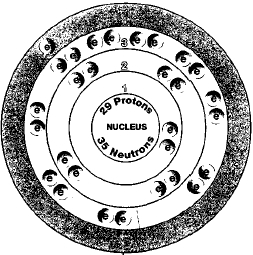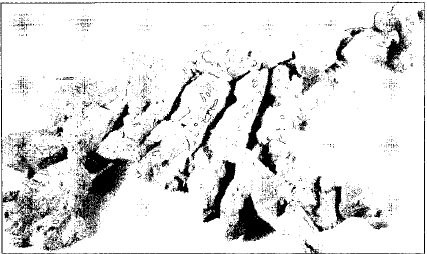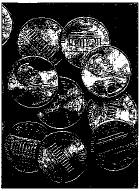COPPER


Overview
Copper was one of the earliest elements known to man. At one time, it could be found lying on the ground in its native state or uncombined state. Copper's distinctive red color made it easy to identify. Early humans used copper for many purposes, including jewelry, tools, and weapons.
Copper is a transition metal, one of several elements found in rows 4 through 7 between Groups 2 and 13 in the periodic table. The periodic table is a chart that shows how chemical elements are related to each other.
SYMBOL
Cu
ATOMIC NUMBER
29
ATOMIC MASS
63.546
FAMILY
Group 11 (IB)
Transition metal
PRONUNCIATION
COP-per
Copper and its compounds have many important uses in modern society. Most electrical equipment has copper wiring. Copper is also used to make many alloys. An alloy is made by melting and mixing two or more metals. The mixture has properties different from those of the individual metals. The most familiar alloys of copper are probably brass and bronze. Many compounds of copper are commercially important, too. They are used as coloring agents in paints, ceramics, inks, varnishes, and enamels.
Discovery and naming
The oldest objects made of copper are beads found in northern Iraq, which date to about 9000 B.C. Tools for working with copper, made in about 5000 B.C. , have also been found. In the New World, Native Americans used copper objects as early as 2000 B.C.
The symbol for copper, Cu, comes from the Latin word cuprum. Cuprum is the ancient name of the island of Cyprus. The Romans obtained much of their copper from Cyprus.
Bronze was one of the first alloys produced. It is primarily copper and tin. The two metals can be melted together rather easily. Humans discovered methods for making the alloy as early as 4000 B.C. Over the next thousand years, bronze was used for a great variety of tools, weapons, jewelry, and other objects. It was such an important metal that the period from 4000 to 3000 B.C. is now known as the Bronze Age. The Iron Age followed the Bronze Age when iron began to replace bronze in tools and weapons.
Physical properties
An important physical property of copper is its color. In fact, people often refer to anything with a reddish-brown tint as being copper colored.
Copper metal is fairly soft and ductile. Ductile means capable of being drawn into wires. Both heat and electricity pass through copper very easily. The high electrical conductivity makes it ideal for many electrical purposes.
Copper has a melting point of 1,083°C (1,982°F) and a boiling point of 2,595°C (4,703°F). Its density is 8.96 grams per cubic centimeter.
Chemical properties
Copper is a moderately active metal. It dissolves in most adds and in alkalis. An alkali is a chemical with properties opposite those of an acid. Sodium hydroxide, commonly found in bleach and drain cleaners like Drano, is an example of an alkali. An important chemical property of copper is the way it reacts with oxygen. In moist air, it combines with water and carbon dioxide. The product of this reaction is called hydrated copper carbonate

Occurrence in nature
The abundance of copper in the Earth's crust is estimated to be about 70 parts per million. It ranks in the upper quarter among elements present in the Earth's crust. Small amounts (about 1 part per billion) also occur in seawater.
At one time, it was not unusual to find copper lying on the ground. However, this is no longer true. Today, copper is obtained from minerals such as azurite, or basic copper carbonate (Cu 2 (OH) 2 CO 3 ); chalcocite, or copper glance or copper sulfide (Cu 2 S); chalcopyrite, or copper pyrites or copper iron sulfide (CuFeS 2 ); cuprite, or copper oxide (Cu 2 O); and malachite, or basic copper carbonate (Cu 2 (OH) 2 CO 3 ).
Bronze, a copper alloy, was such an important metal from 4000 to 3000 B.C. that the era is now known as the Bronze Age.
Copper is mined in more than 50 nations, from Albania and Argentina to Zambia and Zimbabwe. The leading producers are Chile and the United States. Nearly half of the world's copper comes from these two countries. The next largest producers are Canada, Peru, Australia, Russia, and Indonesia. About 98 percent of copper mined in the United States comes from Arizona, Utah, New Mexico, Nevada, and Montana.
Isotopes
There are two naturally occurring isotopes of copper, copper-63 and copper-65. Isotopes are two or more forms of an element. Isotopes differ from each other according to their mass number. The number written to the right of the element's name is the mass number. The mass number represents the number of protons plus neutrons in the nucleus of an atom of the element. The number of protons determines the element, but the number of neutrons in the atom of any one element can vary. Each variation is an isotope.
Nine radioactive isotopes of copper are known also. A radioactive isotope is one that breaks apart and gives off some form of radiation. Radioactive isotopes are produced when very small particles are fired at atoms. These particles stick in the atoms and make them radioactive.
The color of the Statue of Liberty

A n important physical property of copper is the element's color—reddish-brown. An important chemical property is the way copper reacts with oxygen. It turns the reddish-brown tint green. This change of color is a result of the copper combining with water and carbon dioxide in moist air. The product of this reaction is called hydrated copper carbonate.
Perhaps the most famous and dramatic example of this phenomenon is the Statue of Liberty on Ellis Island near New York City. The Statue, or Lady Liberty as it is often called, was a gift to the United States from France. It was dedicated on October 28, 1886. It symbolizes political freedom and democracy.
The Statue of Liberty is covered with copper plates. When it was new, Lady Liberty was copper in color. Over time, the plates slowly turned green. The statue was given a thorough cleaning for its 100th birthday party on July 4, 1986. But the color stayed green. It would take a lot of elbow grease to return the Lady to its original copper color!
Two radioactive isotopes of copper are used in medicine. One is copper-64. This isotope is used to study brain function and to detect Wilson's disease. This disease is the inability to eliminate copper from one's body. The second isotope is copper-67. This isotope can be used to treat cancer. The isotope is injected into the body. It then goes to cells that have become cancerous. In these cells, the isotope gives off radiation that can kill the cancerous cells.
Extraction
Converting copper ore to copper metal often involves many steps. First, the ore is crushed into small pieces. Then the crushed pieces are mixed with water to form a slurry, a soup-like mixture of crushed ore and water. The slurry is spun around in large vats with steel balls to crush/the ore to an even finer powder.
Next, blasts of air are passed through the slurry. Impure copper rises to the top of the mixture and unwanted earthy materials sink to the bottom. The copper mixture is skimmed off the top of the slurry and dissolved in sulfuric acid (H 2 SO 4 ).
Bars of iron are added to the copper/sulfuric acid mixture. Iron is a more active metal than copper. It replaces the copper from the sulfuric acid solution. Copper deposits on the surface of the iron bar where it is easily scraped off.
The copper is still not pure enough for most purposes. The most common method for copper purification relies on electrolysis, which is the process by which an electrical current is used to cause a chemical change, usually the breakdown of some substance. The copper is dissolved in sulfuric acid again and an electric current is passed through the solution. Pure copper metal is deposited on one of the metal electrodes. By repeating this process, the copper is 99.9 percent pure.
Other methods are also used to remove copper from its ores. The method chosen depends on the kind of ore used.
People often refer to anything with a reddish-brown tint as being copper colored.
Uses
The most important application of copper metal is electrical wiring. Nearly every electrical device relies on copper wiring because copper metal is highly conductive and inexpensive. These devices include electric clocks, stoves, portable CD players, and transmission wires that carry electricity. A large skyscraper contains miles of copper wiring for all its electrical needs. Older telephone lines are thick bundles of copper wires. And computers depend on circuit boards imprinted with minute copper pathways.
Alloys of copper, such as bronze and brass, are also used in construction. These alloys find their way into roofs, heating and plumbing systems, and the skeleton of the building itself.
A number of copper alloys have been developed for special purposes. For example, gun metal is an alloy used to make guns. It contains about 90 percent copper and 10 percent tin. Monel metal is an alloy of nickel and copper that is resistant to corrosion (rusting). Coinage metal is a copper alloy from which U.S. coins are made.
How much is a penny worth?

The core of a penny used to be copper. From its introduction in 1909 to 1982, the penny was 95 percent copper. Depending on the year, the other 5 percent was either all zinc or a combination of zinc and tin (bronze). In 1943—during World War II (1939-45)—the penny consisted of zinc-plated steel. This penny was a failure. The steel was magnetic (so it got stuck in vending machines), the zinc corroded easily, and the public often confused it with a dime.
By the 1980s, copper had become more valuable than the one cent that the penny was worth. So in 1982, the U.S. mint switched the penny's core to art inexpensive zinc coated with copper. The rest of that pocket change—dimes, nickels, and quarters—have a core of coinage metal with a thin coating of a silvery metal. Coinage metal is a copper alloy.
A large skyscraper contains miles of copper wiring for all its electrical needs.
Compounds
A number of copper compounds are used as pesticides, chemicals that kill insects and rodents like rats and mice:
basic copper acetate (Cu 2 O(C 2 H 3 O 2 ) 2 ): insecticide (kills insects) and fungicide (kills fungi)
copper chromate (CuCrO 4 ○ 2CuO): fungicide for the treatment of seeds
copper fluorosilicate (CuSiF 6 ): grapevine fungicide
copper methane arsenate (CuCH 3 AsO 3 ): algicide (kills algae)
copper-8-quinolinolate (Cu(C 9 H 6 ON) 2 ): protects fabric from mildew
copper oxalate (CuC 2 O 4 ): seed coating to repel rats
copper oxychloride (3CuO ○ CuCl 2 ): grapevine fungicide
tribasic copper sulfate (CuSO 4 ○ 3Cu(OH) 2 ): fungicide, used as a spray or dust on crops
Other copper compounds are found in battery fluid; fabric dye; fire retardants; food additives for farm animals; fireworks (bright emerald color); manufacture of ceramics and enamels; photographic film; pigments (coloring agents) in paints, metal preservatives, and marine paints; water purification; and wood preservatives.
Turquoise and malachite are semi-precious gemstones made up of copper compounds. Turquoise ranges in color from green to blue.
The color of blood
In humans, the blood that comes from the lungs to the cells is bright red. The red color is caused by oxyhemoglobin (the compound hemoglobin combined with oxygen). Hemoglobin carries oxygen through the blood and is red because of the iron it carries. Compounds of iron are often red or reddish-brown. Blood returning from cells to the lungs (which flows through the veins) is purplish-red because the hemoglobin has lost its oxygen.
Some animals, however, do not have hemoglobin to carry oxygen through the blood. For example, crustaceans (shellfish like lobsters, shrimps, and crabs) use a compound called hemocyanin. Hemocyanin is similar to hemoglobin but contains copper instead of iron. Many copper compounds, including hemocyanin, are blue. Therefore, the blood of a crustacean is blue, not red.
Health effects
Copper is an essential micronutrient for both plants and animals. A micronutrient is an element needed in minute amounts

Copper is critical to enzyme production. An enzyme is a substance that stimulates certain chemical reactions in the body. Without enzymes, the reactions would be too slow. Copper enzymes function in the production of blood vessels, tendons, bones, and nerves. Animals seldom become ill from a lack of copper, but copper-deficiency disorders (problems because of lack of copper) can occur with animals who live on land that lacks copper.
Large amounts of copper in the human body are usually not a problem either. One exception is the condition known as Wilson's disease. Some people are born without the ability to eliminate copper from their bodies. The amount of copper they retain increases. The copper level can become so great it begins to affect a person's brain, liver, or kidneys. Mental illness and death can result. Fortunately, this problem can be treated. The person is given a chemical that combines with the copper. The copper's damaging effects on the body are reduced or eliminated.
business without ripping your pocket
Contact me for more details.
jane